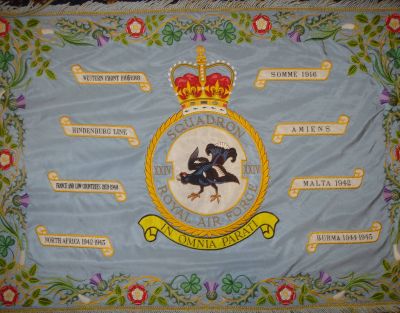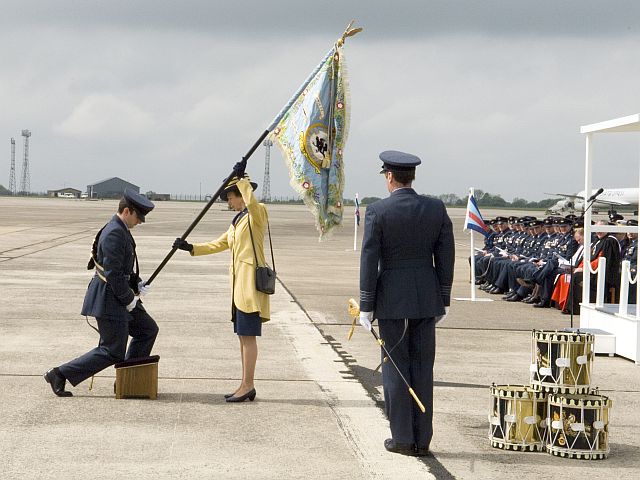History
of No. XXIV Squadron
In
omina parati ( Prepared for all things )
No.
24 Squadron was formed on 1st September 1915, at Hounslow Heath as a fighter
unit, receiving D.H.2s at the end of the year. It moved to France in February,
1916, at a time when German fighters were making reconnaissance and bombing
sorties by the R.F.C. very costly due to the lack of effective fighters.
The squadron's D.H.2s played a large part in defeating enemy attempts
to obtain air superiority over the Western Front in the first half of
1916 but were rapidly overtaken by aircraft development and were obsolete
within a short time. In May, 1917, No.24 re-equipped with D.H.5s which
were flown till the end of 1917 when they were replaced by S.E.5As. For
the rest of the war, the squadron flew fighter patrols over the Western
Front, with occasional ground attack missions, and in February, 1919 returned
to the U.K. where it disbanded on 1st February, 1920.
On 1st April, 1920, No 24 reformed at Kenley as a
communications and training unit with Bristol Fighters. Its communications
tasks involved flying Air Ministry staff and Government members in what
would, in future years, be referred to as V.I.P. flights. It also had
a flight of training aircraft to provide flying practice for pilots on
the staff of the Air Ministry. On 1st February, 1927, the squadron moved
to Northolt and in July. 1933 to Hendon where it remained throughout the
Second World War. After flying a variety of single-engined types since
its formation, No 24 received its first real transport in March, 1935,
a D.H.89A, supplemented by a D.H.86 in October, 1937. It was intended
to equip the squadron with 20 Mentors as standard equipment but the war
overtook this plan and No. 24 began its wartime career with a wide variety
of aircraft of civil design, including Rapides taken over from civil airlines
which were later impressed. For the first nine months of the war, communications
and mail flying between the U.K. and France was a major task but after
June, 1940, flying was confined to the U.K. with the exception of a few
special flights.
In April, 1942, the squadron was transferred to Ferry Command, the predecessor
of Transport Command and in the same month began flights to Malta with
passengers and mail. In April, 1943, a flight of Dakotas was added and
in May the first York was put into service for V.I.P. use. As the Allied
armies liberated more of Europe, the extent of overseas flights increased
and in October, 1944, the squadron was reorganised; in place of the collection
of transport types, the Dakota became the standard equipment of the squadron,
with a flight of Ansons for short range work. In February, 1946, the squadron
moved to Bassingbourn where it absorbed No. 1359 V.I.P. Flight in June.
In November, 1951, Hastings became the standard type and although V.I.P.
flying continued, the squadron became more a general transport unit than
a specialised communications squadron. In January, 1957, No. 24 moved
to Colerne to join a wing of Hastings squadrons and flew this type until
January, 1968, when it began to re-equip with Hercules.
BATTLE
HONOURS
WESTERN
FRONT 1914 - 18
THE SOMME 1916
HINDENBURG LINE
AMIENS
FRANCE AND THE LOW COUNTRIES 1939 - 40
MALTA 1942
NORTH AFRICA 1942 - 1943
BURMA 1944 - 45

The Squadron
Standard was presented to the Squadron by Air Marshal Sir Charles E N
Guest KBE CB, AOC-in-C Transport Command in March 1954. It caries the
maximum number of 8 battle honours.
On 15th September 1981 Her Royal highness The Princess Anne presented
a new Standard to the Squadron. The old standard had, by this time, been
used for 25 years and the need arose for the retirement of the old and
its replacement by the new. The old standard was laid up at the church
of St Michael and All Angels, Lyneham on 28th February 1982.
Once
again the Princess Anne was on hand to present a new set of colours to
XXIV Squadron on the 9 May 2008 at RAF Lyneham. More than 100 spectators
watched 50 officers of RAF Lyneham's 24 Squadron parade in front of the
Princess Royal. Afterwards a new squadron standard was presented by the
royal visitor - the first in 27 years.
The
origins of the colours and standards date back to the Second World War.
On the 25th anniversary of the formation of the RAF, in 1943, King George
VI announced his intention to award ceremonial flags known as standards
to operational squadrons. The squadron must have completed at least 25
years of service to the RAF before receiving one.

|